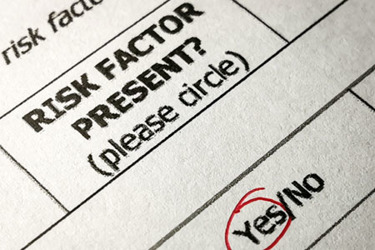Risk Factors To Consider When Selecting Medical Devices For Pharmaceutical Applications
By Tim Sandle, Ph.D.

Using any medical device brings with it an element of risk at the clinical level, where risk represents the probability of occurrence of harm and the consequences of that harm (severity). While risks can be reduced to a residual level, it is not possible to eliminate a risk entirely. Such risks are foremost about injury to the patient and to the user and other persons, with the need to consider risk across the medical device life cycle. Other associated risks may be to the environment or with any data collected. The various risks are set out in ISO 14971.1 It is incumbent upon the purchaser or distributor to assess a new supplier of medical devices for the relative risk to patients and users posed by these devices. This article assesses the common risk areas that require assessment.
There are several critical factors that relate to both the medical device and its usage. These are:
Design And Manufacturing
The medical device risk management assessment should determine if the hazards are caused by the omission or commission of the new device. Where quality by design principles are not in place, a medical device can present a hazard in the following cases:
- If it is poorly manufactured.
- If inadequate attention is paid to the design elements influencing its performance.
- The medical device does something that can cause harm.
- It fails to provide its intended benefit.
To ensure that this factor has been adequately addressed, the purchaser should perform visual and functional inspections as per the product specification form. A related measure is to assess the certificate of compliance (which should be provided with each lot). This acts as a statement that the product has been manufactured in compliance with applicable cGMP requirements.
Risks Associated With Medical Device Users
The way a medical device is used affects its overall safety and effectiveness. Users of medical devices can be healthcare professionals, patients, or family members of patients. Hazards resulting from user error are not unusual, but sometimes their occurrence can vary from nonexistent to frequent, depending on the user’s influence. Medical devices considered to present the highest risks include those that come into contact with the patient's body during intended use or the user's body where the medical device is intended for protection (such as surgical gloves, masks, and others).
Patient and user safety can be assessed through asking risk-centric questions such as what impact the medical device has on the body, based on the nature and duration of its contact with the body. This requires identifying gaps in the available data set on the basis of a risk analysis, with a focus on analyzing the biological safety of the medical device. As well as initial risks at the design stage, consideration needs to be given to changes to the medical device over time, as part of the overall biological safety assessment, and the risk of breakage of a device or device component that exposes body tissue to new or novel materials.
Risks can further arise if the medical device has not been designed appropriately for the patient or the clinician, such as being too fragile, confusing to use, poorly labelled, and so on. To guard against this, human factors should form part of the design process. This refers to how people interact with medical devices and the use conditions that influence the way the user interacts with the device. As set out by the FDA, working through the human factors piece requires acknowledgement and assessment of how users:2
- perceive information from the device,
- interpret the information and make decisions about what to do, and
- manipulate the device, its components, and/or its controls (e.g., modify a setting, replace a component, or stop the device).
Material Toxicity And Degradation
A further element of a good design of a medical device is the appropriate material selection. This relates to the physical and chemical characteristics of the various materials of construction and their composition. In this regard, assessing toxicity is a crucial element in determining how suitable a material is for a specific medical device, in terms of any risk presented to the patient through reactivity.3 For this, the following should be reviewed:
- The material(s) of construction (covering all direct and indirect tissue-contacting materials).
- Intended additives, process contaminants, and residues (taking into account that the sterilization process may lead to residuals).
- Packaging materials that directly or indirectly contact the medical device. Packaging can transfer chemicals to the medical device and then indirectly to the patient or clinician.
- Leachable substances, using a defined method by which maximum tolerable levels can be calculated from available data on health risks.4 A leachable is any chemical removed from a medical device by the action of water or other liquids related to the use of the device. Allowable limits are generally based upon health risks that can be systemic or local, whether immediate or delayed, and they can range in severity from minor localized adverse effects to life-threatening risks. Examples of leachable substances include sterilant residues, process residues, degradation products, solvents, plasticizers, lubricants, catalysts, stabilizers, antioxidants, coloring agents, fillers, and monomers.
- Degradation products can be specific chemicals produced from polymers, ceramics, and metals or products generated by mechanical degradation in the form of particulate matter. Degradation can extend to wear, load, or fatigue, such as with load-bearing medical devices used as total joint prostheses or where friction and associated irritation occurs.
Biological Risks
Biological risks may also be present, and these require assessing in relation to the use of the device. Biological hazards include bacteria, molds, yeasts, viruses, transmissible spongiform encephalopathy (TSE) agents, and other pathogens. Testing performed to support a biological evaluation should be subject to validation and traceability as with all quality control tests.
In most instances, biological risks and toxicology can only be demonstrated for a particular material in relation to a defined set of circumstances, which include the purpose for which it is used and the tissues with which it comes into contact.5
Sterilization
One risk for which there should be a strong degree of control is the sterilization of the medical device. As well as ensuring that the medical device to be marketed is state of the art, and hence suitable for its intended use, the manufacturer also needs to ensure that where the device is required to be rendered sterile within its primary packaging, this has been completed in a validated and reproducible way and with sufficient controls in place. Failure to do so can lead to an improperly sterilized medical device, which will pose a serious risk of patient infection through the presence of microorganisms.
Pyrogenicity
In addition to sterilization, pyrogenicity tests may need to be included as part of a biological evaluation so that detection of material-mediated pyrogenic reactions of extracts of medical devices or materials can be performed. The primary pyrogenic risk is bacterial endotoxin.
Interaction With Other Devices
Sometimes, under specific circumstances, many medical devices may be used within close proximity to one another. The manufacturer of the device usually considers such a case at the design stage, but the ingenuity of device users to devise new systems may outstrip the manufacturer’s expectations. Since the user’s behavior is often unpredictable, manufacturers of medical devices must consider factors related to the interaction of devices during the risk assessment.
Subsequent Risks
It may be necessary to reassess the risks should any changes occur in the source or specification of the materials used in manufacturing the product. Other reasons include any change in the formulation, processing, primary packaging, or sterilization of the product and any variation in the intended use of the product or subsequent evidence that emerges suggesting that the product can produce adverse biological effects when used in humans.6
Summary
This article discusses the key risk factors in relation to medical device development and continuous manufacture. In working through the list, any history of clinical use or human exposure data can prove useful in making the assessment, together with understanding the material composition. Searching through the previous regulatory approval history can also prove useful.
References
- ISO 14971:2019 Medical devices — Application of risk management to medical devices, International Standards Organization, Geneva, Switzerland
- FDA (2018) Human Factors and Medical Devices. At: https://www.fda.gov/medical-devices/device-advice-comprehensive-regulatory-assistance/human-factors-and-medical-devices
- Mumtaz, M.M., Sipes, I.G., Clewell, H.J. and Yang, R.S.H. (1993). Risk assessment of chemical mixtures: Biologic and toxicologic issues Fund. Appl. Toxicol. 21: 258-269
- Conine, D., Naumann, B. and Hecker, L. (1992). Setting Health-Based Residue Limits For Contaminants in Pharmaceuticals and Medical Devices. Quality Assurance: Good Practice, Regulation, and the Law. 1(3): 171-180
- Black, J., Biological Performance of Materials: Fundamentals of Biocompatibility, CRC Press, 2006
- Factors to Consider Regarding Risk Benefit Risk in Medical Device Product Availability, Compliance, and Enforcement Decisions, FDA, https://www.fda.gov/files/medical devices/published/Factors-to-Consider-Regarding-Benefit-Risk-in-Medical-Device-Product-Availability--Compliance--and-Enforcement-Decisions---Guidance-for-Industry-and-Food-and-Drug-Administration-Staff.pdf
About The Author:
 Tim Sandle, Ph.D., is a pharmaceutical professional with wide experience in microbiology and quality assurance. He is the author of more than 30 books relating to pharmaceuticals, healthcare, and life sciences, as well as over 170 peer-reviewed papers and some 500 technical articles. Sandle has presented at over 200 events and he currently works at Bio Products Laboratory Ltd. (BPL), and he is a visiting professor at the University of Manchester and University College London, as well as a consultant to the pharmaceutical industry. Visit his microbiology website at https://www.pharmamicroresources.com.
Tim Sandle, Ph.D., is a pharmaceutical professional with wide experience in microbiology and quality assurance. He is the author of more than 30 books relating to pharmaceuticals, healthcare, and life sciences, as well as over 170 peer-reviewed papers and some 500 technical articles. Sandle has presented at over 200 events and he currently works at Bio Products Laboratory Ltd. (BPL), and he is a visiting professor at the University of Manchester and University College London, as well as a consultant to the pharmaceutical industry. Visit his microbiology website at https://www.pharmamicroresources.com.
